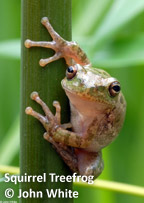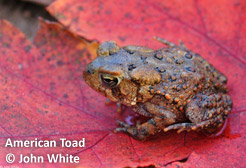Teachers, please join us in raising awareness about Virginia’s frogs!

Teaching about frogs and other amphibians fits well with the VA Science Standards of Learning. For example, students can learn about the life cycle and natural history of the frog when you’re covering the Life Processes strand, such as in K.6 “living things…need water to survive,” or 1.5 “animals have life needs – water,” or 2.4 “animals undergo a series of orderly changes in their life cycles.”
In the Living Systems strand of the Science SOLs, you can link frogs to the importance of good water quality, such as in 3.6 “water-related environments support a diversity of plants and animals that share limited resources” and 6.7 “human interactions that affect watershed systems.”
Similarly, there are SOLs suited to this topic in the Resources strand, such as 3.10 “effects of human activity on water quality” and 4.8 “watersheds and water resources.” Certainly upper grade levels can benefit from outdoor learning in Life Science and Biology classes, too.
There may also be opportunities to partner with local volunteer organizations that can work with you and your students to improve habitat for frogs and other amphibians on school property through DGIF’s Schoolyard Habitat program. For more information and lesson ideas, please visit the websites below.

Lesson Plans and Activities
- Hop Into Action – Amphibian Curriculum Guide NSTA[Grades K-4]
- Amphibian ART Curriculum [Grades K-3]
- Amphibian Alert! Curriculum [Grades 2-5]
- What is a Life Cycle?: Session 4.3 – Frogs, VDOE Grade 2 Unit: Virginia Animals & Their Habitats [Grade 2]
- Let’s Hear it for Herps! Nature Scope Guide, National Wildlife Federation, c. 1997 – a book of ready-to-use activities on amphibians and reptiles, available for purchase online from varied book retailers [Grades K-7]
- How to Build a Toad Home/Small Frog Habitat (PDF)
- Frog and Toad Coloring Pages (PDF)
- Who is Calling Tonight – a Frog Call Activity (PDF)
 Schoolyard Habitats
Schoolyard Habitats
Schoolyard Habitats make wonderful outdoor classrooms where your students can observe and learn about frogs, birds, butterflies and many other wildlife species. Learn how to start one at your school by visiting the DGIF Schoolyard Habitat program webpage.

